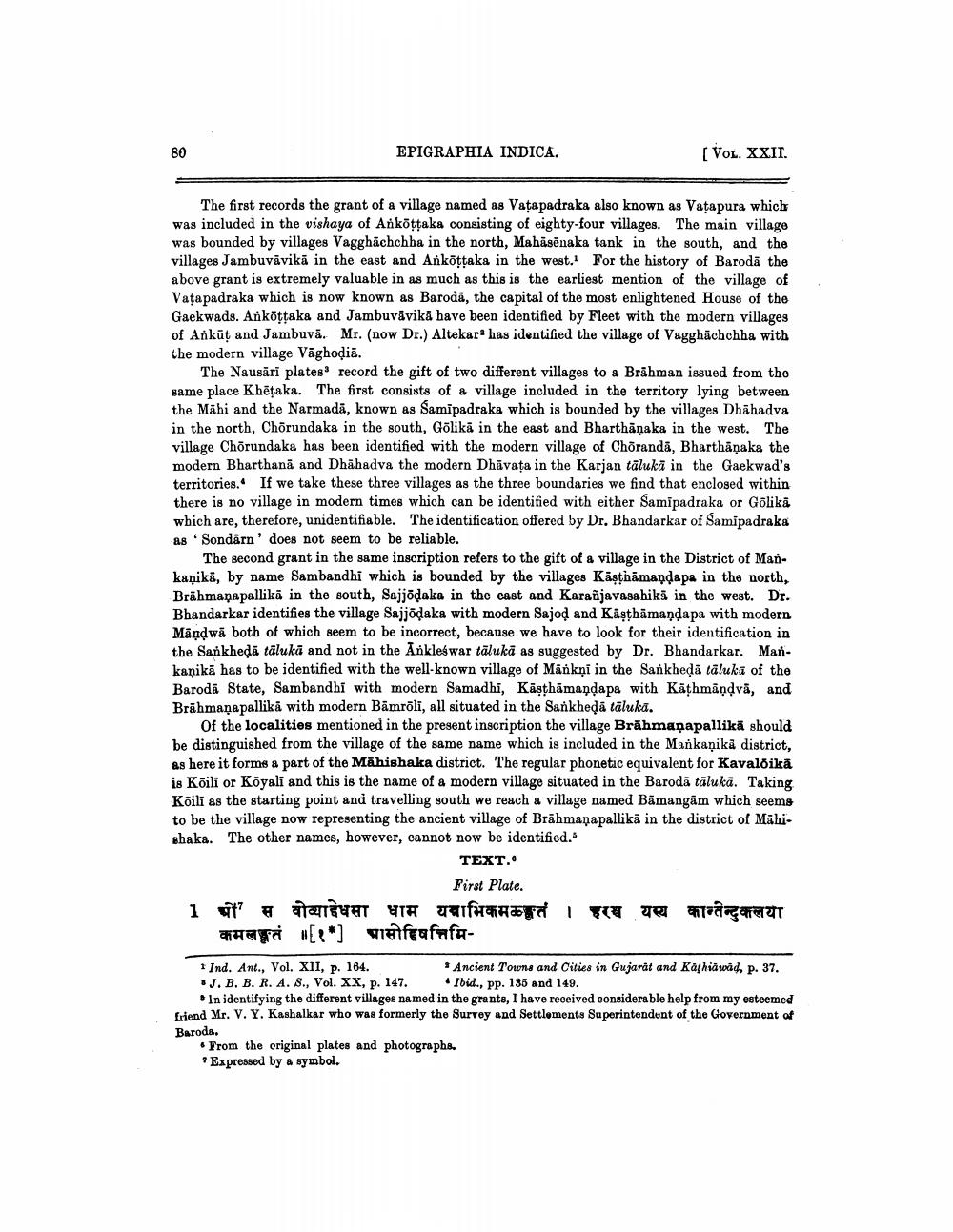________________
EPIGRAPHIA INDICA.
[VOL. XXII.
The first records the grant of a village named as Vatapadraka also known as Vațapura which was included in the vishaya of Ankottaka consisting of eighty-four villages. The main village was bounded by villages Vaggháchchha in the north, Mahāsēnaka tank in the south, and the villages Jambuvāvikā in the east and Ankoţtaka in the west. For the history of Baroda the above grant is extremely valuable in as much as this is the earliest mention of the village of Vatapadraka which is now known as Barodā, the capital of the most enlightened House of the Gaekwads. Anköttaka and Jambuvāvikā have been identified by Fleet with the modern villages of Anküț and Jambuvā. Mr. (now Dr.) Altekar has identified the village of Vagghächchha with the modern village Vāghodiā.
The Nausārī plates: record the gift of two different villages to a Brāhman issued from the same place Khētaka. The first consists of a village included in the territory lying between the Māhi and the Narmadā, known as Samīpadraka which is bounded by the villages Dhahadva in the north, Chörundaka in the south, Gõlikā in the east and Bharthanaka in the west. The village Chörundaka has been identified with the modern village of Choranda, Bharthāņaka the modern Bharthana and Dhāhadva the modern Dhāvata in the Karjan tālukā in the Gaekwad's territories. If we take these three villages as the three boundaries we find that enclosed within there is no village in modern times which can be identified with either Samīpadraka or Gölikā wbich are, therefore, unidentifiable. The identification offered by Dr. Bhandarkar of Samīpadraka as Sondārn' does not seem to be reliable.
The second grant in the same inscription refers to the gift of a village in the District of Markaņikā, by name Sambandhi which is bounded by the villages Kästhāmaņdapa in the north, Brāhmanapallikā in the south, Sajjõdaka in the east and Karañjavasahiki in the west. Dr. Bhandarkar identifies the village Sajjõdaka with modern Sajod and Käşthamandapa with modern Mändwā both of which seem to be incorrect, because we have to look for their identification in the Sankhedā tāluk, and not in the Ankleswar tālukā as suggested by Dr. Bhandarkar. Mankanikā has to be identified with the well-known village of Mankņi in the Sankhedā tālukā of the Barodā State, Sambandhi with modern Samadhi, Kästhāmaņdapa with Kāthmāņdva, and Brāhmaṇapallikā with modern Bamrõli, all situated in the Sankhedā tāluka.
Of the localities mentioned in the present inscription the village Brāhmaṇapallikā should be distinguished from the village of the same name which is included in the Mankaņiká district, as here it forms a part of the Māhishaka district. The regular phonetic equivalent for Kavalõikā is Kõili or Köyali and this is the name of a modern village situated in the Barodā tāluka. Taking Kõili as the starting point and travelling south we reach a village named Båmangām which seems to be the village now representing the ancient village of Brāhmaṇapallikä in the district of Māhishaka. The other names, however, cannot now be identified."
TEXT.
First Plate. 1ों ' स वोव्याधसा धाम यवाभिकमळतं । हरच यस्य कान्तेन्दुकलया
F #*] gefeafafa
1 Ind. Ant., Vol. XII, p. 164.
* Ancient Towns and Cities in Gujarat and Kathiawid, p. 37. *J. B. B. R. A. 8., Vol. XX, p. 147. Ibid., pp. 135 and 149.
In identifying the different villages named in the grants, I have received considerable help from my esteemed Eriend Mr. V. Y. Kashalkar who was formerly the Survey and Settlements Superintendent of the Government of Baroda.
• From the original plates and photographs
Expressed by a symbol.




